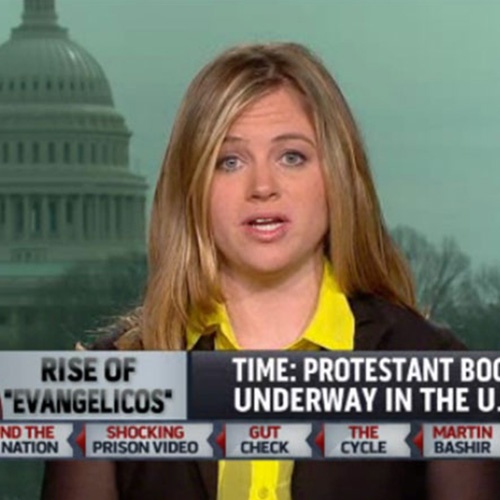
The numbers don’t lie, right? How could they? The PEW Forum’s polls say it all: Religion is going down, and secularism is on the rise. This is epitomized in the rise of the “nones,” the second largest “religious” group in the nation. 23% of the nation is either atheistic, agnostic, or “nothing in particular.” This is the news; this is the religious headline of the 21st century. Maybe, on occasion, this narrative can be supplemented with the maddening tales of the faithful who have hypocritically forayed into the sins they so publicly condemn.Why then, would Elizabeth Dias, a young, aspiring journalist with a Master’s degree from an Ivy League school, devote her life and career to covering religious news? What did one of the most prestigious news sources in the nation see in this woman, who has already written or contributed to six cover stories before her 35th birthday? A quick read of her work shows a different vision: a complex, yet hopeful insight. She gives voice to a religious narrative that attempts to see beyond the simplified view of disheartening polls, media scandals, and the routine “spiritual-but-not-religious” diatribe.
To call Ms. Dias, correspondent for Time Magazine, “promising” or “up-and-coming” in the field of religious news would be a disservice. In a six-year journalistic career, (despite not having specific journalistic aspirations earlier in life, nor any journalistic degree) she has already placed herself among the elites of the field, especially among those who cover the intersection of religion, politics, and culture. With headlines empty of the bleak, simplified outlook that can become the norm in religious reporting, Ms. Dias constructs intricate, vivid pictures of American religious life. Her reports emerge from church dining halls, college campuses, city streets, campaign trails, and papal jets. She shows not only the diversity and depth of religious life in the United States, but also helps to deconstruct the previously mentioned narrative of faith. Yes, the population may be moving away from organized religion, but Dias has been quick to point out the complexity of such a stat (for example, the large percentage of nones who still maintain some form of religious practice in their life). Likewise she observed that the love and admiration for Pope Francis among millenials, a particularly secular group, could only be equated to their massive support for President Obama in 2008. Miss Dias’s cover stories on Pope Francis’s visit to America, Evangelical revival in the Latino community, and cultural response to the death of Trayvon Martin have placed her voice solidly in the public square, showing a range as unquestionable as her passion.
Her magnum opus (so far, at least) must be her collaboration with Howard Chua-Eoan on Pope Francis as Time’s 2013 Person of the Year. Their feature, “The People’s Pope”, is meticulously researched, tracing Jorge Bergolio’s footsteps from the neighborhoods of Buenos Aires to the chair of Saint Peter. The piece’s clear knowledge of inner-Vatican proceedings, Church history, and future ecclesial needs is only matched by its sensible respect and regard for Francis’s significant contributions in such a short time.
This standard of writing should be applauded for straddling the line of objective, yet emotive and expressive reporting. Unfortunately, this art is often lost in modern journalism’s social media-focused bonanza. In the face of this sensationalism that contrasts so sharply with her nuance, Dias has not held back from critiquing her peers. When the media exploded over a statement by Pope Francis that re-affirmed Church teaching on evolution and divine creation (spoiler alert: they’re not at odds with each other), Dias commented that “almost every outlet has got the story wrong, proving once again that the mainstream media has nearly no understanding of the Church… This embarrassing narrative repeats itself over and over in Francis coverage.”
Most recently, Dias’s coverage has been centered on the presidential campaign, writing pieces on the candidates’ religious backgrounds, their attempts to sway the various bodies of voting Christians, and their pastors who offer prayer and support in times of need. While nearly every aspect of the Clinton and Trump campaign have gone under x-ray scrutiny, their personal religious beliefs and backgrounds have seen little light. Dias has had a chance to dive into these hidden aspects, writing pieces on the pastor who prays with Mr. Trump before his big speeches, and or the evangelical bishop who felt no need to preach to her congregation after Secretary Clinton spoke to them about the Prodigal Son.
The importance of Ms. Dias’s role in media cannot be overstated. There is a temptation in media to tamp down, mute, or eliminate religious aspects of stories, unless a pope is being elected or Islamic controversy is raising hairs. However, to ignore this pulsing, changing, and vital aspect of life and culture in America is to be ignorant to the everyday American. To ignore the religious aspect of a story is to ignore a part of humanity that is as old as history itself, and Ms. Dias’s work insures that a full human picture will be present in our news for many years to come.
For these stories and more, Ms. Dias has been handed a bundle of awards, most recently the George W. Hunt Prize, which will be presented on Thursday, September 29th at 4pm at Saint Thomas More Chapel at Yale. Given to writers under the age of 50 for a significant and intelligent contribution to journalism and writing, the award is collaboration between America Magazine and the Saint Thomas More Chapel at Yale.
photo credit: Time Magazine



